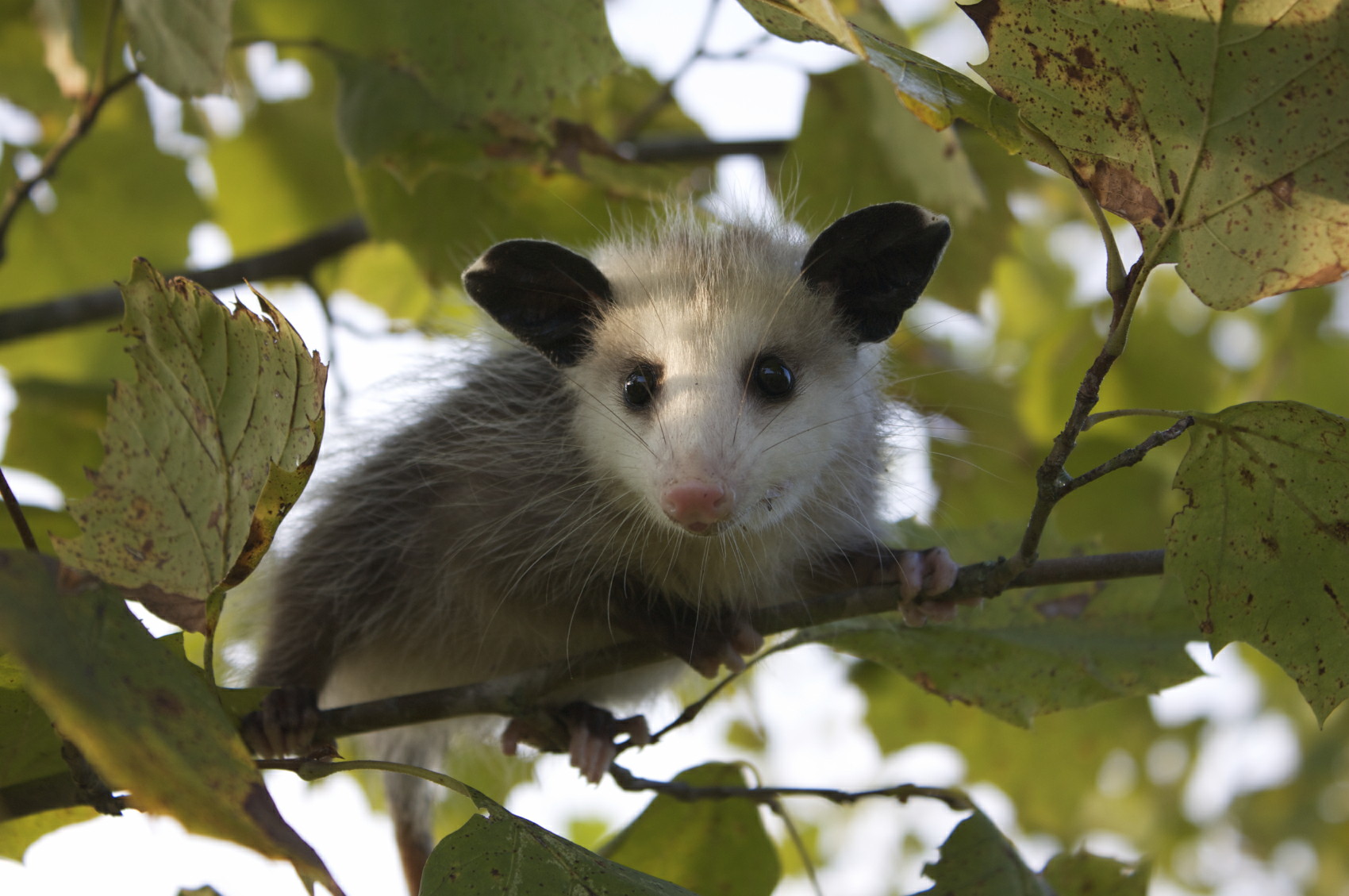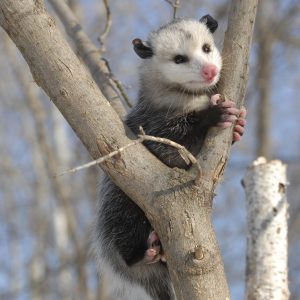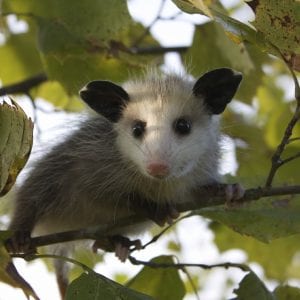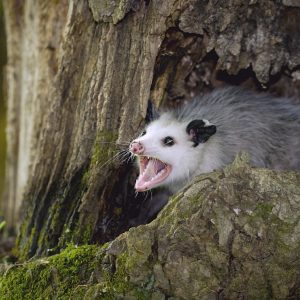Forestry & Wildlife

The Virginia opossum (Didelphis virginiana) is an animal that can be both a benefit and a nuisance to landowners. It is important to appreciate their contributions to the ecosystem and know the proper methods for managing their presence.
Known widely for playing dead when frightened, the opossum is a creature with a unique place among Alabama’s wildlife. The opossum is the only marsupial (pouched mammal) native to the United States.
As other animals are vanishing from forests, opossums appear to be flourishing due to their remarkable ability to adapt. Their rapid development, along with other characteristics, such as resistance to snake venom, make opossums of particular interest in the medical field. Yet their adaptability and development also contribute to their nuisance factor. Striking a balance between appreciating their benefits and controlling their activities is vital in preserving this important species.
Characteristics
The Virginia opossum is a medium-sized mammal that lives 1 to 3 years in the wild. It weighs 4 to 13 pounds in adulthood and has about fifty teeth, more than most other mammals.
The opossum’s face is white with a dark V-shaped marking. Its body is covered with dense, gray underfur and long, gray or black guard hairs that protrude past the soft underfur. They appear primarily white, gray, or black, depending on the color and density of these guard hairs. Cinnamon-colored and albino forms have been documented as well.
The opossum’s legs are usually covered with black hair. Their ears are hairless and black. Their paws are hairless and white, black, or pink in color. And their tails are mostly naked except for a few bristly hairs. Opossums have a prehensile (gripping) tail and an opposable (grasping) thumb on the hind foot.
The female’s pouch is perhaps the most interesting of all the opossum’s features. Much like kangaroos, opossums give birth to relatively undeveloped young that complete development inside the mother’s marsupium (pouch) located on her underside between her hind legs. Only females have marsupia. The pouch is small and not fully formed in females that have not had a litter. Once she is pregnant, the pouch enlarges to prepare for the birth of her young. This pouch also can be closed to protect the offspring.
Females usually reproduce during the first year after they are born. Most females can produce two litters in that year (one in winter and one in spring), although some may produce three. The gestation period is only 13 days.
At birth, the young weigh less than 1/100 ounce each and are about the size of a honeybee. The young climb to the marsupium without assistance, using their sense of smell. Opossums can give birth to as many as 20 offspring at once, but not all will survive. Opossums have an average of 13 nipples, so only those able to latch onto a nipple within the pouch that produces milk survive.
After about 2 months, the young are sufficiently developed to venture outside the mother’s pouch. On average, only seven young survive to emerge. After this, they can be seen hitching a ride on her back. They do not hang from her tail suspended over her back as popularly believed. Young opossums disperse and can fend for themselves at 3 to 4 months old.
- Figure 1. The Virginia opossum is the only marsupial native to the United States.
- Figure 2. Young opossums venture outside the pouch at about 2 months of age and disperse at 3 to 4 months.disperse at 3 to 4 months of age.
- Figure 3. Some opossums may gape and hiss rather than play dead.
Behavior
Opossums are terrestrial (ground-dwelling) but also spend significant time in trees. They use their prehensile tails to assist during climbing. In contrast to popular cartoons and folklore, opossums rarely hang by their tail and do not sleep in this position.
Opossums are solitary creatures but are not territorial and may have overlapping home ranges. Males do not seem to tolerate other males as well as they do females. Opossums are nocturnal, preferring to forage at night rather than in the daytime. Opossums do not hibernate. Even in the northernmost part of their range, they can be found in winter searching for food during the warmest part of the day.
Despite their many interesting behaviors, opossums are renowned for one in particular: playing dead when faced with danger to avoid predation. When threatened, opossums appear to go into a catatonic state. They drool and exude a noxious substance from their anal glands. This behavior helps keep predators from attacking. However, this intriguing method of defense is not the most common method practiced. Most often when confronted with danger, opossums try to escape. They are likely to gape and hiss or growl if cornered, revealing their fifty teeth instead of “playing ’possum.”
Habitat
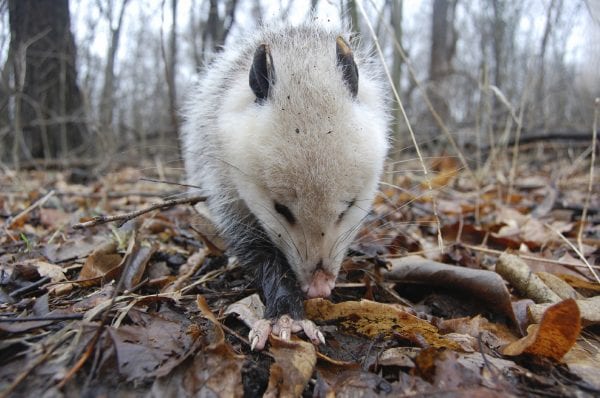
Figure 4. Opossums can live in many types of habitats.
The opossum is a common inhabitant of North America. Native to Central America and the southern United States, opossums have expanded their range northward over the past 100 years. Their range now extends as far north as Ontario, Canada. They live east to the Atlantic coast and west into the Great Plains, mainly where trees and water occur together to form their natural habitat or anywhere the presence of humans can support them.
Populations also have been introduced in the West. They now exist along the Pacific Coast from California to Washington and northward into British Columbia, Canada. Colorado, Idaho, Arizona, and New Mexico also have populations of opossums, although there is some disagreement as to whether these populations were introduced. Their northward expansion is believed to be limited by cold weather. Opossums can suffer from starvation and frostbite on their ears and tail in northern parts of their range.
The home range for opossums is 50 to 300 acres. They often live in forested areas with brushy cover and available water. Open areas usually are avoided, although they may make trips into these places to forage.
Opossums can live in rural, urban, and suburban areas, adapting easily to life among humans. Although they do not hibernate, they will create sleeping dens in cavities of trees or logs, sheds, barns, piles of building materials, and crevices in rocks. Sometimes they attempt to den in attics or under porches.
Diet
Opossums are opportunists; they will eat almost anything. Most of their diet consists of animal matter, such as eggs, crustaceans, reptiles, amphibians, birds, small mammals, and carrion (already dead animals). Insects, in particular, are a staple food. They have been known to raid chicken houses on occasion.
The opossum diet includes fruits, such as persimmons, apples, plums, blackberries, hackberries, wild grapes, and nuts. They will occasionally take advantage of gardens and crops (particularly corn). In these cases, they usually are not a significant source of damage. In urban and suburban settings, opossums scavenge garbage and bird seeds. Not surprisingly, they also enjoy pet food. Many people have gone onto the porch to feed dogs and cats only to find an opossum cleaning out the bowl.
Opossums are also food for many other types of animals. Foxes, coyotes, bobcats, and great-horned owls are common predators of the opossum. Let’s not forget that humans sometimes eat opossums too.
Benefits and Uses
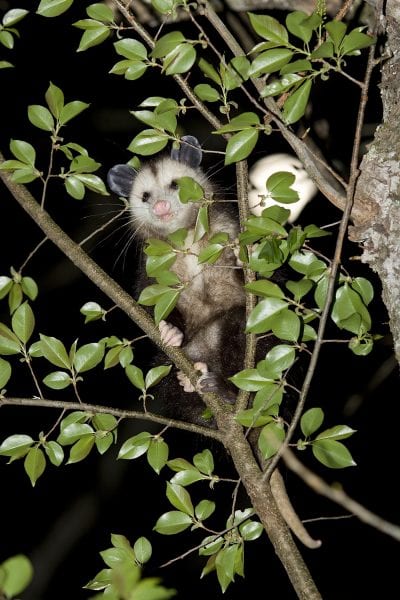
Figure 5. Although not a common practice as it once was, opossums are sometimes hunted or trapped for food or pelt.
Although many people focus on the negative aspects of opossums, there are some significant benefits. The opossum has been an important fur-bearing species. Although pelts are not as high in demand as those of other species, they can be used as a substitute for more expensive furs.
In Alabama, opossums are classified as furbearers and game and may be trapped and hunted in accordance with state laws and regulations. Opossum hunting traditionally has been an entertaining sport for those who enjoy hunting with hounds. The possum hunt historically has engaged aristocrats such as Franklin D. Roosevelt. At one time, hunting opossums for food was much more common than for sport. For current hunting and wildlife regulations in Alabama, go to the Alabama Department of Conservation and Natural Resources website at www.outdooralabama.com/.
Opossums are valuable animals in many other ways to humans and the ecosystems in which they live. For example, insects and rodents are two major components of the opossum’s diet. By consuming large numbers of these from where humans live, they may help to control damage to gardens and lawns. Because carrion is also a diet component, opossums may play an essential role in the delicate balance of nature by acting as cleanup crew.
Opossums are of particular interest in the medical field. Due to their rapid development, they may provide insight into the care of premature babies and the growth of organs. In addition, opossums have a natural resistance to snake venom due to the presence of a protein in their blood known as lethal toxin-neutralizing factor (LTNF). This protein has allowed researchers to find a better way to treat snake-bite victims, and it is now produced synthetically.
Management
Opossums are adaptable animals and can live in various habitats, both natural and those created by humans. Because opossums are habitat generalists, little encouragement is needed to attract them to an area.
General backyard-management strategies for other native wildlife, such as creating den sites, planting natural food sources, and increasing access to water, will benefit opossums. Brushy areas, wood piles, and stacks of rocks provide excellent cover for many wildlife species. Old snags (standing dead trees) and fallen logs often provide denning cavities and can be left as they occur. Native plants, such as crabapples, persimmons, blackberries, and hackberries, provide natural food sources to many species.
Damage and Control
Because opossums are so adaptable to varying environments and sometimes choose to live close to humans, the problem may not be how to create better habitat for opossums but how to control them.
Opossums occasionally eat eggs, chickens, and crop items. They opportunistically prey upon eggs of turkeys and quail, which may also concern wildlife managers. Contrary to public opinion and perception, however, predation on nests by opossums and other medium-sized mammals (such as raccoons and skunks) is not the cause of low game populations.
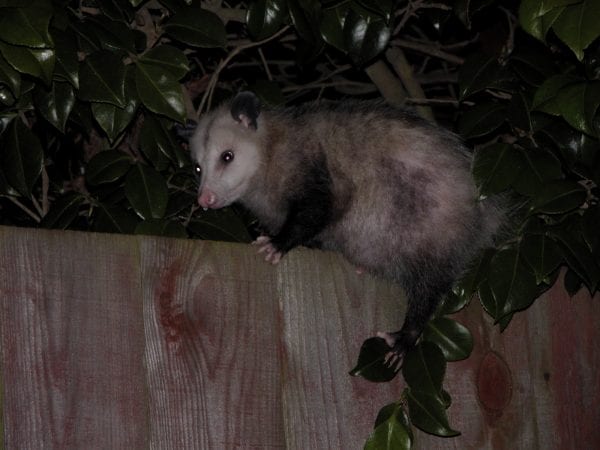
Figure 6. Opossums are at home in residential areas and may cause problems for homeowners.
When opossums den in houses, sheds, and barns, they can cause damage to property by creating or enlarging entry holes, tearing insulation and other soft items during denning activities, chewing on wires and water lines, and defecating in unacceptable locations. These damages can be costly. In addition, they sometimes eat and scatter garbage and consume food left for pets.
Opossums often are viewed as a threat to people and pets because they hiss when cornered, although they rarely follow through with the bluff. They often are believed to carry many diseases transferrable to humans and pets. In reality, they have a remarkable resistance to many viruses and rarely contract rabies, parvovirus, distemper, or feline hepatitis, which are common in other mammals.
Opossums do carry one type of parasite (Sarcocystis neurona) that can cause a serious disease known as equine protozoal myeloencephalitis (EPM) in horses. They may also carry ticks, fleas, roundworms, and other common parasites.
The first and easiest way to control damage caused by opossums is to remove whatever is attracting them. Bring in pet food at night or, if you store it outside, keep it in metal bins that latch. Place garbage in containers on the morning of pickup and close the lids securely.
Close any access points to potential denning areas, such as attics, garages, and crawl spaces. Remove any brushy areas or piles of wood and rocks around the yard and plug up any obvious holes that the opossums may be using.
In summer, remove any available sources of water, such as bird baths, which may bring opossums into your yard overnight (these can be replaced in the morning). Large dogs usually discourage opossums from approaching.
If you find that none of these actions control the problem, other options may be helpful. Pest-control or animal-removal services in your area will remove the opossums for a fee. By Alabama regulation, property owners may remove one opossum per damage incident without acquiring a special take, capture, or kill permit. If you are in an area that permits the discharge of firearms, you can remove opossums by shooting them.
Trapping is a particularly efficient strategy for removing opossums. Be careful during trapping to avoid personal injury and unintentional capture of pets and other wildlife. Leghold traps (no. 1½) and live traps (at least 2′ × 8″ × 8″) are appropriate and can be set easily.
Once the opossum is trapped, it must be destroyed or relocated. It is illegal to relocate opossums across county lines or drainage basins due to the possibility of spreading disease. Plus, it will simply shift the problem to another area, and the survival rate of relocated animals often is low.
It is illegal to keep an opossum as a pet. If you find an injured or orphaned opossum, do not attempt to capture the animal. It is best to leave it alone and let nature to take its course.
For questions concerning acceptable or suggested forms of removal, contact your county Extension agent for assistance.
Conclusion
The remarkable Virginia opossum is here to stay. As the Southeast becomes increasingly populated, more conflicts between people and opossums will likely occur. Homeowners can learn to recognize potential conflicts and avoid them or minimize damages where possible.
Opossums are a unique member of Alabama’s wildlife and play an essential role in the function of the ecosystem. As Aldo Leopold, the father of wildlife management, said, “The first step in intelligent tinkering is to keep all the parts.” The Virginia opossum is one of these important parts.
 Revised by Mark Smith, Professor, Forestry, Wildlife, and Environment, Auburn University. Originally written by Amber D. Marable, former Extension 4-H Agent, Auburn University
Revised by Mark Smith, Professor, Forestry, Wildlife, and Environment, Auburn University. Originally written by Amber D. Marable, former Extension 4-H Agent, Auburn University
Revised July 2022, Virginia Opossum: Our Only Native Marsupial, ANR-1414

